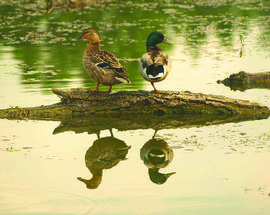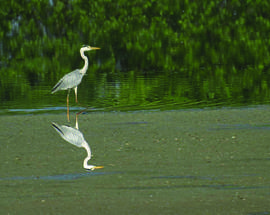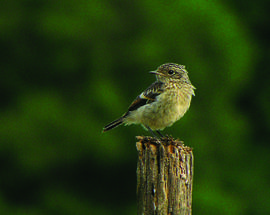Birdwatching in Croatia is only recently gaining in popularity, partly due to the interest shown by visitors from other European countries, notably Great Britain. However, local ornithological societies and other organisations, including schools, are also making a significant contribution through monitoring the numbers of birds, organising volunteer camps for tagging birds and raising awareness about the need not only to protect birds but the environment as a whole.
According to data from the State Directorate for the Protection of Nature and the Environment, in December 1999 there were 371 bird species in Croatia, an exceptionally high number for a country of this size. There are 228 nesting species, of which 78 are registered as endangered species in Europe. At the same time, Croatia has an exceptionally high number of endangered species due to disappearing habitats, especially wetlands, and due to poaching. The majority of protected species are to be found in hard-to-reach areas such as mountain peaks, cliff faces and gorges, and areas such as the Neretva delta on the Adriatic coast and along the Sava and Drava rivers in the north, as well as close to the large fish farms to be found in Pannonian Croatia.
Today in Croatia there are 19 bird reserves engaged in nature protection in areas where there are large bird populations, large numbers of species of birds, or where endangered species are to be found. Birdlife International has identified 23 Important Bird Areas in Croatia, while the State Directorate for the Protection of Nature and the Environment has recognized 40 areas which are important for bird life. Some of these areas are bird reserves, some form parts of national parks or nature parks, while others do not enjoy any form of protection.
Although there are birdwatching opportunities all year round, the liveliest seasons are spring and autumn. Autumn signals both the departure of species that nest in Croatia and the arrival of visitors from northern Europe and Asia. In spring, the species that spend their winters in the warmer climes of Africa return to the nest. At any time, you might spot a species that is just passing through en route to somewhere else: Croatia is a bottleneck on the migratory route to and from Africa for a large number of European bird species. There are guidebooks available to help you identify species and understand their behavior.
The best times of the day for birdwatching are the early morning and early evening. At these times, birds are at their most active, especially during the summer when birds, like people, avoid the hottest part of the day.
Of course, if you do go birdwatching, it's vital to take care not to disturb the birds. Large numbers of visitors to national parks, nature parks and bird reserves may be distressing to their inhabitants, and disturbing the birds prevents us from being able to observe their natural behavior. It is advisable to avoid getting too close to bird nests, since you risk the parents abandoning the nests, which is disastrous, especially where endangered species are concerned.
The equipment you need for birdwatching includes good quality binoculars and a handbook which classifies birds by species. You’ll also be glad of a good camera and sensible clothing. Obviously, you should avoid bright colors which will scare the birds away.
Many birdwatchers pass on the information they collect to the institutions responsible for the protection of birds or to ornithological societies, which is of great help to these organizations in monitoring changes in the number of birds, in their behavior and habitats.
Since birdwatching in Croatia is still not very common, below we list a range of organizations which might be of interest to nature lovers, although there might neither be much information about birds in specific nor professional guides. Before visiting any protected area, we ask you to please contact the organization responsible, which will give you any instructions and warnings necessary to protect fragile habitats, enabling as many people as possible to enjoy the beauty of nature as well as learning how to protect it.
Kvarner Islands
There are two bird reserves around the island of Krk, but be prepared – both are rather difficult to get to. The first is on the uninhabited island of Prvić, which can only be reached by boat from Baška on Krk island. The other, Kuntrep, is on Krk itself and can be reached by boat, by car or on foot. Among the most important inhabitants of the Kvarner island group is the Griffon Vulture (Gyps fulvus). The vultures can be spotted on the cliffs that rise above the sea, a legacy of the drop in the sea level since the end of the last ice age. It is really important to keep your distance as any noise from engines or voices scares the young birds, which may fall into the sea and drown as a result. Please also be careful if you visit by boat if a strong north wind is blowing in this area as this can be dangerous. For more information, contact: Baška Tourist Association, at www.tz-baska.hr.
There are also two reserves on the island of Cres: Fojiška – Podpredošćica (Kruna, in the northern part of the island) and Mali Bok – Koromačna (Pod Okladi, in central Cres). These are the most significant habitats of the Griffon Vulture in the Kvarner islands. For more information, please contact the eco centre Caput Insulae Beli, Beli, www.supovi.hr.
Učka Nature Park
This nature park encompasses the Učka mountain and part of the Ćićarija mountain. Not much research has been done on bird life, although it is known for sure that the Golden Eagle (Aquila chrysaetos) has nesting places here, while the Griffon Vulture can sometimes been spotted on the cliffs.
Učka Nature Park, Liganj 42, Lovran, www.pp-ucka.hr.
Zadar area
Lake Vrana Nature Park / Lake Vrana Bird Reserve
Lake Vrana lies alongside the coast road between Zadar and Šibenik, or more precisely, between Pirovac and Pakoštane. 241 bird species have been logged in the area of the Nature Park, 102 of which nest here. This is a good place to spot the Purple Heron (Ardea purpurea), Great Bittern (Botaurus stellaris), Corncrake (Crex crex) and Squacco Heron (Ardeola ralloides), all endangered species in Europe.
The Park staff can organise visits on foot or by boat to birdwatching sites upon request. The price of a visit, complete with an expert guide, is 300kn for the whole group, and the trip can take up to five hours. Entry tickets to the Nature Park are also payable (20kn adults, children up to 15 yrs free). Visitors should bring their own birdwatching equipment, and call ahead to announce group visits.
Lake Vrana Nature Park, Kralja Petra Svačića 2, Biograd, www.vransko-jezero.hr.
Pag island
The island of Pag is home to the following bird reserves: Kolansko blato, Blato Rogoza, Veliko blato and Malo blato. All of these are marshlands which are home to species including the Gadwall (Anas strepera), Montagu’s Harrier (Circus pygargus) and Calandra Lark (Melanocorypha calandra), which are endangered in Europe. Call into the Tourist Association in Povljana to buy entry tickets for the Veliko blato reserve, which has a hide with a checklist.
Povljana Tourist Association, Stjepana Radića 20, Povljana, www.tz-povljana.hr
Kolan Tourist Association, Trg kralja Tomislava, Kolan, www.visitkolan.hr
Telašćica Nature Park
This fantastic nature park in the Telašćica Bay on Dugi Otok is also designated an Important Bird Area. 110 bird species have been sighted here. Perhaps the most exciting birds to spot are birds of prey such as the Peregrine Falcon (Falco peregrinus). The Park is accessible by boats laid on by travel agencies and private boat owners, or from dry land from the town of Sali. Entry tickets cost 28-60kn. If you require a guide, please phone one week in advance.
Telašćica Nature Park, Ulica Danijela Grbin bb, Sali, www.telascica.hr
Kornati National Park
A national park made up of some 90 islands, islets and reefs spanning the area between Biograd and Šibenik. The land is owned by the residents of the surrounding islands. This is also an Important Bird Area, although it’s insufficiently researched with respect to fauna and flora so there are no accurate data on numbers of species. In common with other island habitats, owls, seagulls and the European Shag (no tittering, you at the back) can be spotted here. You can visit Kornati if you have your own boat, or as part of a trip organised by a travel agencies and private boat owners in the areas of Šibenik, Murter, Zadar, Biograd and the islands in the Zadar area. Tickets are for sale in the Park itself and in local travel agencies, and cost 150 - 750kn depending on the size of the boat. There are no guided tours.
Kornati National Park, Butina 2, Murter, tel. www.kornati.hr
Paklenica National Park
The Paklenica National Park occupies the coastal part of the southern Velebit mountains. The Park is famous for the large difference in altitudes you cross as you travel through it, complete with changes in climate, all in a relatively small area. Bird species you might spot on the rock and cliff faces include the Rock Nuthatch (Sitta neumayer) and the Blue Rock Thrush (Monticola solitarius). Rare and endangered birds of prey to be found here include the Golden Eagle (Aquila chrysaetos), Peregrine Falcon (Falco peregrinus), Short-Toed Eagle (Circaetus gallicus) and Goshawk (Accipiter gentiles). Entry tickets to the park cost 30-40kn depending on the time of year. Birdwatching as an individual is not permitted: please call ahead to organise a tour with one of the Park’s official guides.
Paklenica National Park, dr. F. Tuđmana 14a, Starigrad - Paklenica, www.paklenica.hr.
Velebit Nature Park / Northern Velebit National Park
The Velebit is the longest mountain range in Croatia, stretching 145km from Vratnik near Senj to the River Zrmanja near Zadar. It is not classified as an Important Bird Area, nor does it have any bird reserves, but it does encompass three Parks: the Northern Velebit National Park, the Velebit Nature Park and the Paklenica National Park. It has two strict nature reserves (both in the Northern Velebit National Park) as well as nature reserves for plant life, and the area is rich in flora and fauna. Nesting sides of the following birds are to be found here: the Eurasian Pygmy Owl (Glaucidium passerinum), the Ortolan Bunting (Emberiza hortulana), the Western Capercaillie or Wood Grouse (Tetrao urogallus), White Backed Woodpecker (Dendrocopus leucotos) and the the Boreal Owl (Aegolius funereus).
Velebit National Park, Kaniža Gospićka 4b, Gospić, www.pp-velebit.hr.
Northern Velebit Nature Park, Krasno 96, Krasno, www.np-sjeverni-velebit.hr.
Dubrovnik area
The tiny islands of Mrkan, Bobara and Supetar were declared special bird reserves in 1975 due to their importance as nesting sites for large numbers of Yellow-Legged or Caspian Gulls (Larus cachinnans). This island group, known as the Cavtat islands, is in the Southern Adriatic at the entrance to the Župa Bay. It is located about 2km from Cavtat.
Neretva Delta
The Neretva Delta is an Important Bird Area and is one of four Ramsar wetland sites in Croatia, with a protection plan. However, none of this has yet been recognised on a state or political level in Croatia. Part of the site (close to Metković) has nevertheless been awarded protection, and in this area you will find the bird reserves Pod gredom, Orepak and Prud, as well as a special bird and fish reserve in the southeast part of the Neretva river delta.
Javna ustanova za upravljanje zaštićenim prirodnim vrijednostima na području Dubrovačko-neretvanske županije, Branitelja Dubrovnika 41, www.zastita-prirode-dnz.hr
Osijek Area
A visit to the Kopački rit Nature Park is an absolute must for any visitor to Osijek. This is the flood plain of two great rivers, the Danube and the Drava. Kopački rit is one of four Ramsar wetland sites in Croatia, rich in flora and fauna, and is an important natural heritage site both on the national and European levels. It is especially rich in bird life, with the largest number of nesting sites of the White-Tailed Eagle in this part of Europe, and the most numerous colonies of cormorants and herons in Croatia. The size of groups of birdwatchers is limited to 10 people, and birdwatching is strictly by appointment at least 10 days in advance. The price is 100kn per hour per person for a programme that lasts about 6 hours.
Kopački rit Nature Park, Šandora Petefija 33, Bilje, www.kopacki-rit.com.
Zagreb Area
There are three bird reserves in the Zagreb area. They are managed by Zeleni prsten, an organisation which takes care of protected areas in Zagreb County. A programme of birdwatching tours with expert guides is currently under preparation.
The Crna Mlaka Special Bird Reserve
An Important Bird Area close to the small town of Jastrebarsko between Zagreb and Karlovac, which is private property and therefore visits are not possible. This is one of four Ramsar wetland areas in Croatia. Part of the reserve is marshland while part is forested, and 235 species have been recorded in the area. The most common marshland species are: the Great Crested Grebe (Podiceps cristatus), the Grey, Purple, Squacco and Night Heron, the Great Egret, Mallard Duck, Ferruginous Duck, Coot, Common Snipe, White-Winged Black Tern and Common Tern. Reed beds provide nesting sites for the Reed Warbler, Great Reed Warbler and others. The forest provides important nesting areas for the Black Stork, White-Tailed Eagle and Lesser-Spotted Eagle.
The River Sava around Zaprešić and Strmec
The area on the banks of the River Sava west of Podsused on the western edge of Zagreb has a network of tributaries, canals, sand and shingle banks and water meadows which is an especially important site for some important and rare bird species such as the Hoopoe, European Bee-Eater, Eurasian Hobby, Little Ringed Plover, Spotted Sandpiper, Common Kingfisher, Nightingale and Barred Warbler. The presence of the Penduline Tit, which builds hanging nests which were once used as slippers for children is of particular interest.
Jastrebarsko groves
The marshy soil along the left bank of the Okičnica stream in Crna Mlaka is important as a habitat of the White-Tailed Eagle, a bird of prey that is recovering after a period of near-extinction.
Note: this is not a specialist or expert text on birdwatching but a general overview of birdwatching in Croatia. The text has been prepared in cooperation with the web portal www.ptice.net and with the kind assistance of Mr Darko Podravec, with our thanks.








Comments